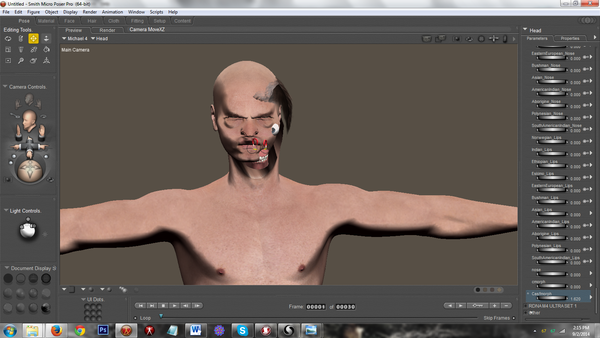Tried to make a morph and it didn't work...
 Upirium
Posts: 711
Upirium
Posts: 711
On Sculptris. I know you are supposed to export the file as a wavefront obj. I exported the head in wavefront and imported it into Sculptris. Made sure symmetry was off. Messed what I needed to, which was not a lot, but I exported the Obj and loaded it as a morph target on my M4.
But when I try to apply the morph, it doesn't really show any changes I did. It just does ...well, this is what happens, in the image below.
Can someone tell me what I can do to fix this? Or why this happened? Or how I can NOT screw up?


ohno.png
1600 x 900 - 1M
Post edited by Upirium on


Comments
Any time I have seen such a mess with a model, is when the vertex order has been changed.
I never use Sculptris, but in the export option, is there an option to 'Maintain vertex order' or similar? That looks like the problem to me. If you had removed or added any vertices, Morph Loader would not have created a morph in the first place, so I think I must be right :)
I don't think I added anything, just moved the morph around.
When I export the only option is to save it as an obj...
A few things:
1. What figure is this that you have exported?
2. Did you export at base level?
3. Did you export with DAZ as the units of measure (this is the recommended)?
4. Did you make sure that you used only tools which moved the mesh and didn't actually add any geometry (as I have been told that Sculptris does have brushes that add geometry)?
5. When you exported back, did you import with the same units of measure as you exported?
6. If this was over, say, Michael 6 which is a morph of the G2M, then it would need to have reverse deformation set to yes in the Morph Loader.
(Edit: apologies, just looked at the picture again and you're using Poser. Not sure how Poser needs things, but you may want to at least do points 2 and 4.)
I don't know what 'base level' means
I exported the head of M4 but I used a figure I already had created. See, I have a character I am trying to perfect and he is pretty much done but I had to do some finishing touches with sculptris like smoothing parts of the nose and adding creases to places I can't in Poser
I don't really know anything about this 'units of measurement' i just exported the head as a wavefront obj, exported as a wavefront objs, and loaded the morph target.
The tools I used were grab, crease, and smooth. That's it.
Base level refers to the Sub DIvision Level, exports must be at base level meaning no Subdivision active on the mesh.
Units of measurement refers to the export options tab and adjusts scaling of the mesh for imports and exports.
The main thing with a morph is that it needs to match the original mesh when being applied if sizing/scaling is different the morph will distort in unexpected ways to match your target mesh. Its best to test your work flow before creating detailed morphs. Get a process sorted that works by first testing a simple morph.
What is subdivision...? How would I know if it was active in the mesh? And how would I know at what unit of measurement to export it, or if I would need to?
Sub Division is a method of refining a mesh to add detail by adding levels of Sub Division for example you could gradually convert a cube to a sphere by using varying levels of Sub D. But its generally used to take off those hard edges. A mesh is made up of Vertex's and Edges which in effect are straight lines, when they are used to model something like the human body which is mostly made up of curved edges you may notice an odd angle here or there where the mesh edges meet. This is where Sub Division comes in, rather then just making the initial mesh more detailed using a Sub D algorithm will add detail but conserve resource usage.
The most important thing is that the mesh must be initially exported at 100 percent size as a base mesh. And this must remain constant when importing and exporting to Sculptris and finally back to Poser for the finished morph. The only edits to the base mesh should be the morph changes you have made otherwise the morph will fail.
Nope. Do not move the .obj around.
Import in, morph, export out.
The OP is using Poser Pro 2014. To the OP, what unit of measure are you using in Poser? By default, Poser uses it's own Poser Native Units. Each PNU is somewhere around 8 or so feet. Most modelling apps default to 1 unit equals 1cm. This can cause issues with morphs and their obj files exported out of the modelling app and back into Poser.
I haven't used the Scupturis but I have run into this issue with other modelling apps.
As for subdivision, that is not an issue with the Generation 4 figures in Poser. Subdivision applies more to Genesis and the G2F/M figures.
Nope. Do not move the .obj around.
Import in, morph, export out.
What I mean is I used the tools to alter the face
I may have moved the OBJ though in Sculptris so I could get closer to it...
I'm also not sure if I clicked 'don't resize' ..
Perhaps this is the issue?
As long as it is only the viewport and not the figure that you move, rotate, or scale (which for the viewport would be zoom in/out), you should be fine.
Since this is Poser, I am not entirely sure of the process.
I also never used Sculptris for doing morphs, so I never bothered to learn which ones added any geometry. If Sculptris shows the number of verts or faces, you could check to see if the number exported in and the number exported out matches. That's often a good way to make sure no geometry has been added or lost.
Well, I don't know how much help you could be on this since you don't use it, but when I don't resize the obj, this is what happens. And if I try to zoom in to edit the morph, it just disappears. It's actually really tiny, and this is as far as I can zoom in without the entire thing disappearing
Without using either app, I would say that looks like some kind of camera clipping if the model disappears as you zoom in.
The key is consistency, the mesh needs to go in and out of Poser with the same scaling applied.
A morph is modifying the mesh based on the differences in vert positioning so it is critical that the size is the same.
Are there options to import and export from sculptris while keeping the same scaling ratio?
E.g if its imported at 200% it would need to be exported at 50% to keep the same scaling ratio when importing back to Poser.
Creating Morphs is not really program specific and many of the common issues are across the board so I wouldn't immediately discard advice based on "Well, I don’t know how much help you could be on this since you don’t use it"
I wasn't trying to sound rude or anything I just wasn't sure if I should ask that specific person for help.
I think I may have figured it out, though. I exported the head and I forgot to select 'export as morph target' or whatever. So I did that, zeroed the m4 model I had it on, and applied it and it seemed to work...
So I'm going to mess around and see what happens
I tested it by stretching the nose out really far and importing it back into Poser and it added the stretchy nose and the face it was supposed to look like.
Sounds promising, definitely the best way to go foward.
I've learnt from experience that testing and getting the workflow right is an essential first step.
Especially when working with morphing as they can be upset by the smallest of issues which is quite often just neglecting to tick a small box.
:)
.....and it isn't always easy to find out the right information for exactly what to do for the figure you're using as well as the program from which you export, and the one in which you create the morph. Just a different set of tools from which I use, but I'm glad to see you may be getting to your goal.
Ok, you create the morphed head obj in Scupturis.
You export it from Scupturis. You launch Poser and load M4.
You go through the steps to create a morph target in Poser. Does Poser accept the morphed head obj as the morph target or do you receive on the of the warning boxes Poser will throw when the verts have been altered in the modelling app?
If Poser applies the morphed obj and spawns the morph dial, is the first screen shot what happens when you dial the morph dial to one?
Have you tired spawning the morph target from your modeller using the base M4? No other morph packs injected? Just the base and whatever morphs it comes with.
The M4 you are using the morphed head with is the standard M4 and not one you have changed to Poser skinning or one of WM versions isn't it?
Whether Poser or Studio M4's pose (and any scaling done to it) needs to be zeroed before exporting.